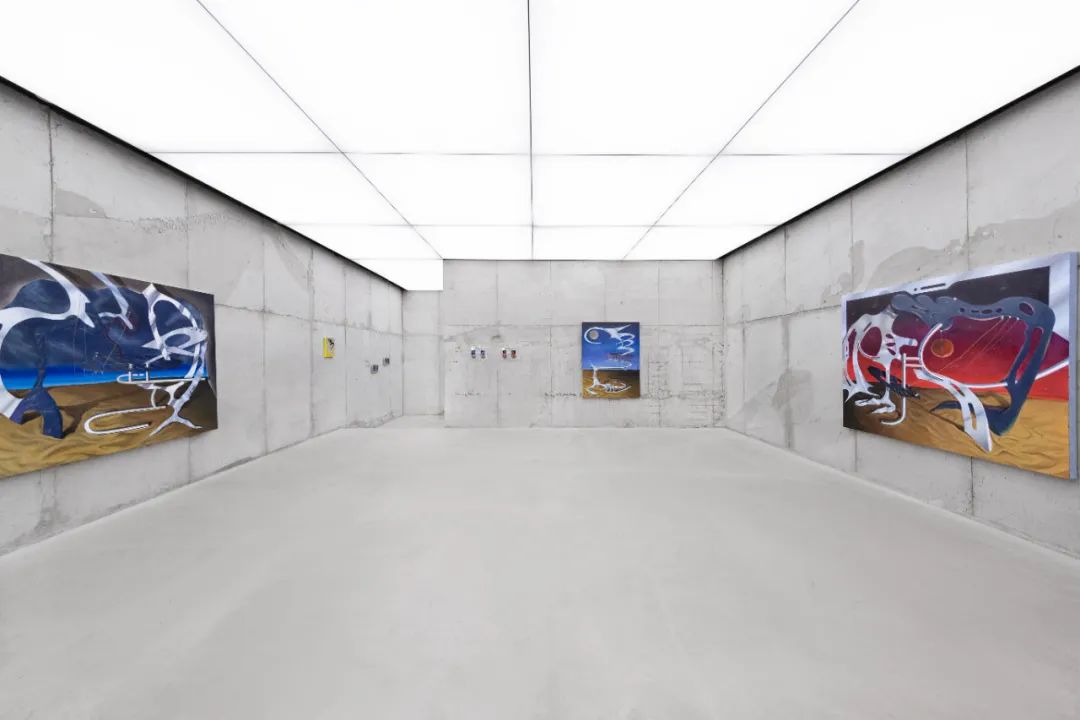
Installation View, Artwork ©吴凌昊
" 人的造物与人本身的关系就是很微妙的,有时人会被自己的造物影响和规训。"

吴凌昊新作中呈现出大量的金属材质,它们被弧线所切割,乍一看像分割重组的器具,进而构成了人的形象,隐约显露出人体(异化)的线条。每幅画作中不止有一个形象;形象之间,不同方向的力处于临时的平衡状态。这产生了一种模糊、暧昧的效果,令人分不清是在工具之间、人之间,还是工具和人之间进行着拉锯和博弈。
In his new works, Wu Linghao presents an abundance of metallic materials. They are cut by curves, and at first glance, they resemble segmented and reassembled apparatus which further form human figures, subtly revealing the lines of human body (alienation). Each artwork contains more than one figure; among these figures, forces of different directions are in a temporary balance. This creates a vague and ambiguous effect, making it unclear whether the tug of war and contest are happening among tools, among humans, or between tools and humans.

Installation View, Artwork ©吴凌昊
"在这批作品中我讨论的内核其实是控制与规训。"
"The core of these works is actually about control and discipline."
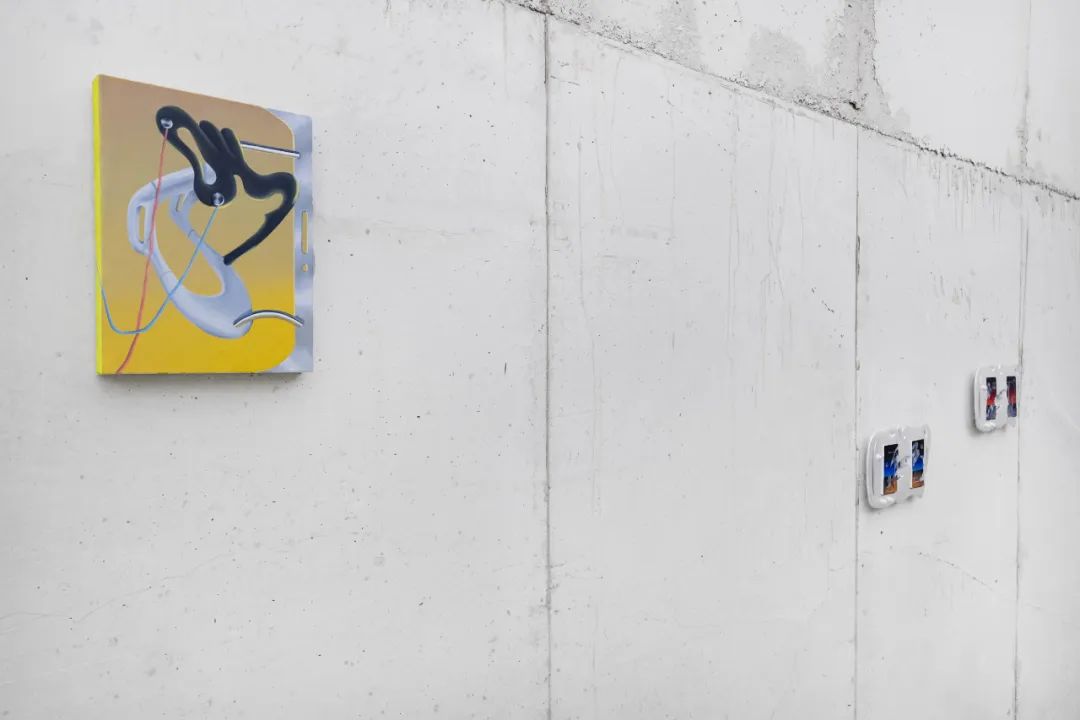
Installation View, Artwork ©吴凌昊
吴凌昊用冰冷又富有诗意的创作呈现出工具与人间的这一紧张关系。工具的“在手性”这一神秘而原始的冲动,使人在亘久的时空中得以不断地演进——荒芜渐渐变成了历史,呼啸的风中混入了言说的声响。吴凌昊的作品似乎遵循着同样的演化过程:有些作品起初着眼于塑造一个身体形象,然而在创作过程中逐渐演变成一个工具或装置。相反,有些作品从设计一个目标装置出发,但最终却逐渐展现出人的形象。这个模糊的形象——它的易变、流动、支撑、增生和嫁接——恰恰是欲望、身体和器具三者间相互造就、生成的一幅动态画像。
Wu Linghao displays this tense relationship between tools and humans through his cold yet poetic creations. The mysterious and primal impulse of a tool being "at hand" enables humans to evolve continuously through the endless timespace—desolation gradually becomes history, and voices of speech mingle with the howling winds. Wu Linghao's works seem to follow a similar evolutionary process: some works initially focus on sculpting a human figure, but gradually morph into a tool or apparatus during the creative process. Conversely, some works start with designing a target apparatus, but eventually gradually present a human figure. This vague figure, with its variability, fluidity, support, proliferation and grafting, precisely becomes a dynamic portrait generated by the mutual constitution among desire, body and apparatus.
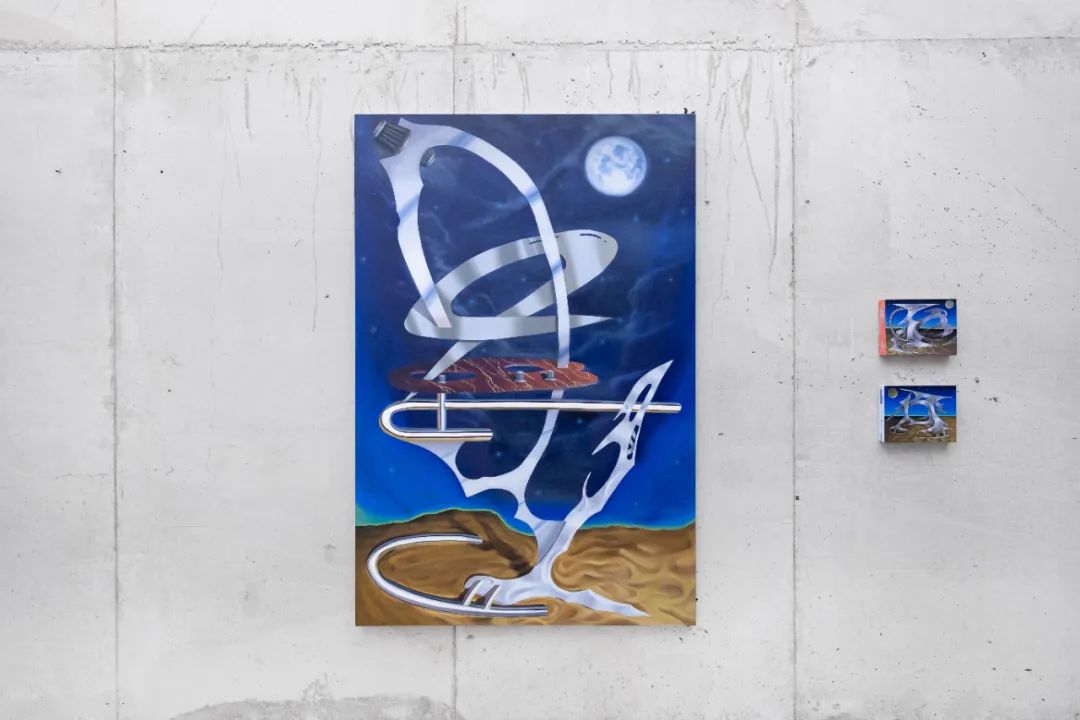
Installation View, Artwork ©吴凌昊
人与工具相互发明了彼此。直到当代社会,这种关系变得越来越显性,人们正越来越强烈的意识到,没有任何一种工具和发明是中性的。它们以“义肢”和“生命增强”的形式,不断侵入我们的生物学身体,同时进入潜意识和梦境。自由意志、力比多冲动,正成为“控制论”社会不断试图擦除的人类基因和天性。
Humans and tools have mutually invented each other. Up to the contemporary society, this relationship becomes increasingly explicit. People are becoming more and more aware that no tool or invention is neutral. They constantly invade our biological body in the form of "prosthetics" and "life enhancement", meanwhile entering our subconscious and dreams. Free will and libidinal impulses are becoming the human genes and nature that the "cybernetic" society is continually trying to erase.
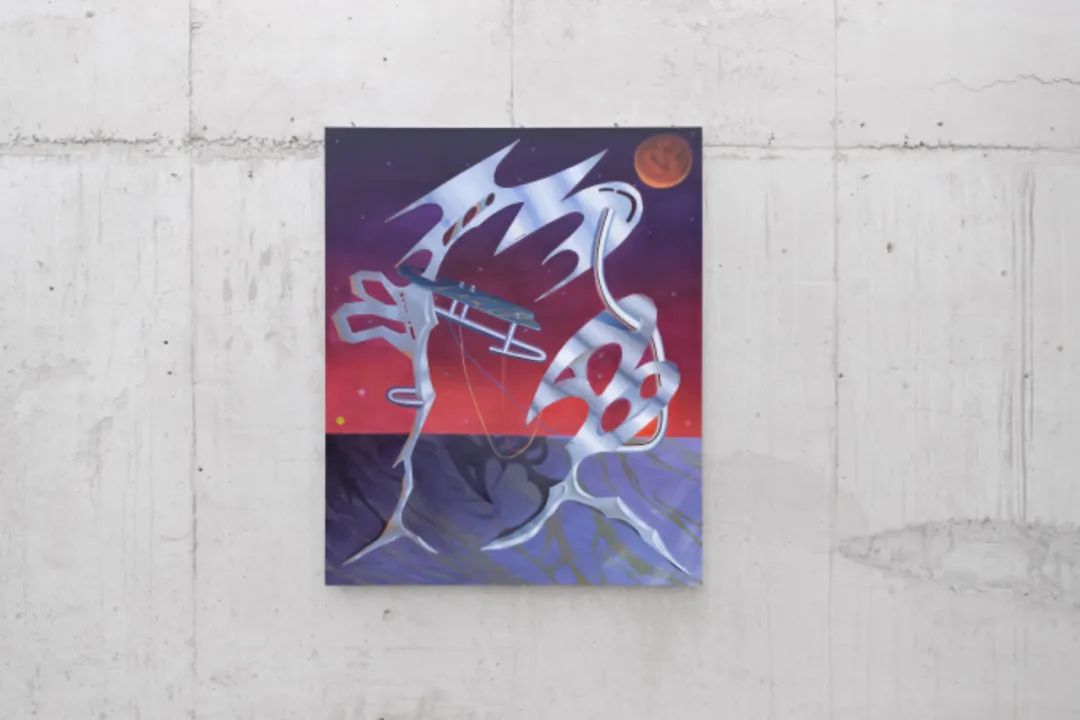
阅读 Read, 170×140cm, 布面油画 Oil on canvas, 2023
艺术家这次试图跳脱出之前作品对“界面”——当下欲望的操纵平台——的兴趣,进而转向了一个更加具有历史感的领域:欲望、工具,二者的相互发明及由此产生的控制。欲望,它在身体和精神上得到满足和不满,主导着我们今日对科技发展的渴望和恐惧:更多的满足,更少的伤害。
In this instance, the artist attempts to jump out of the previous, the manipulation platform of current desires, interest in "interface", and turn to a more historically sensed field: the mutual invention of desire and tools, and the control arising from it. Desire, whether satisfied or unsatisfied physically and mentally, is dominating our desire and fear towards technological development today: more satisfaction, less harm.
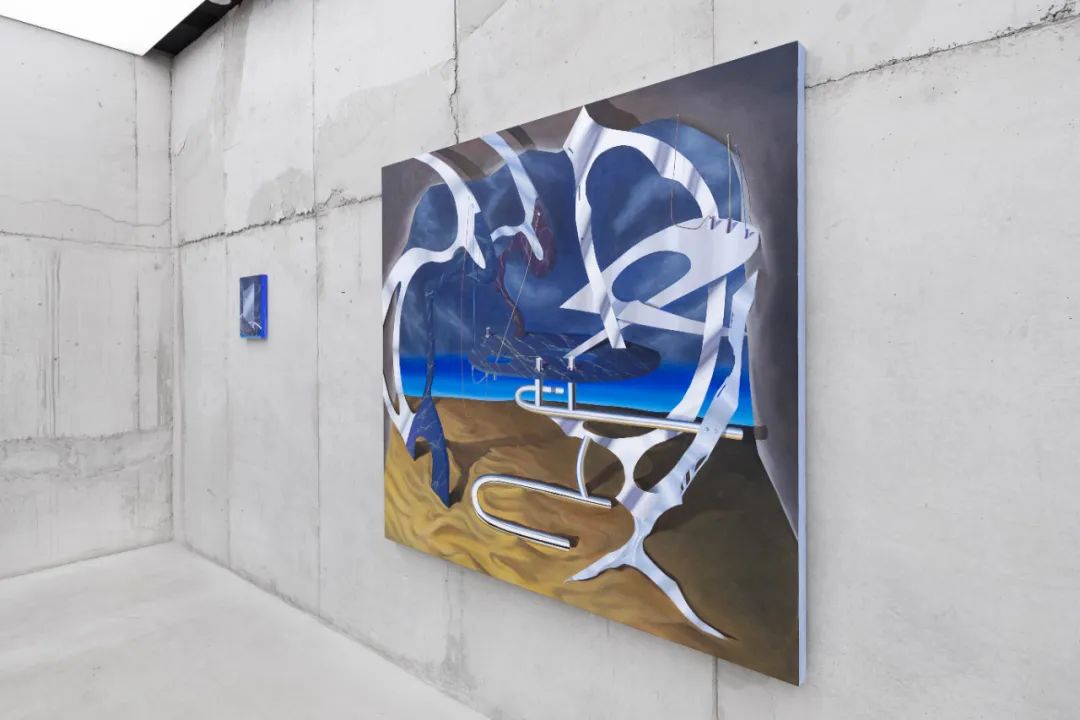
Installation View, Artwork ©吴凌昊
展览中,吴凌昊初次使用了3D打印的画框,这既可被视为他对绘画边界的一次崭新探索,也可以认为是对绘画主题恰到好处的延伸:绘画中的主体和机器一直在生成和发明,溢出了自身的边界,从实在界不断地涌入符号界。
In the exhibition, Wu Linghao used 3D printed frames for the first time, which can be seen as a fresh exploration of the boundaries of painting, and also as a fitting extension of the painting theme: the subjects and machines in the paintings have been continuously generating and inventing, overflowing their own boundaries, and constantly flowing from the realm of the real into the realm of the symbolic.
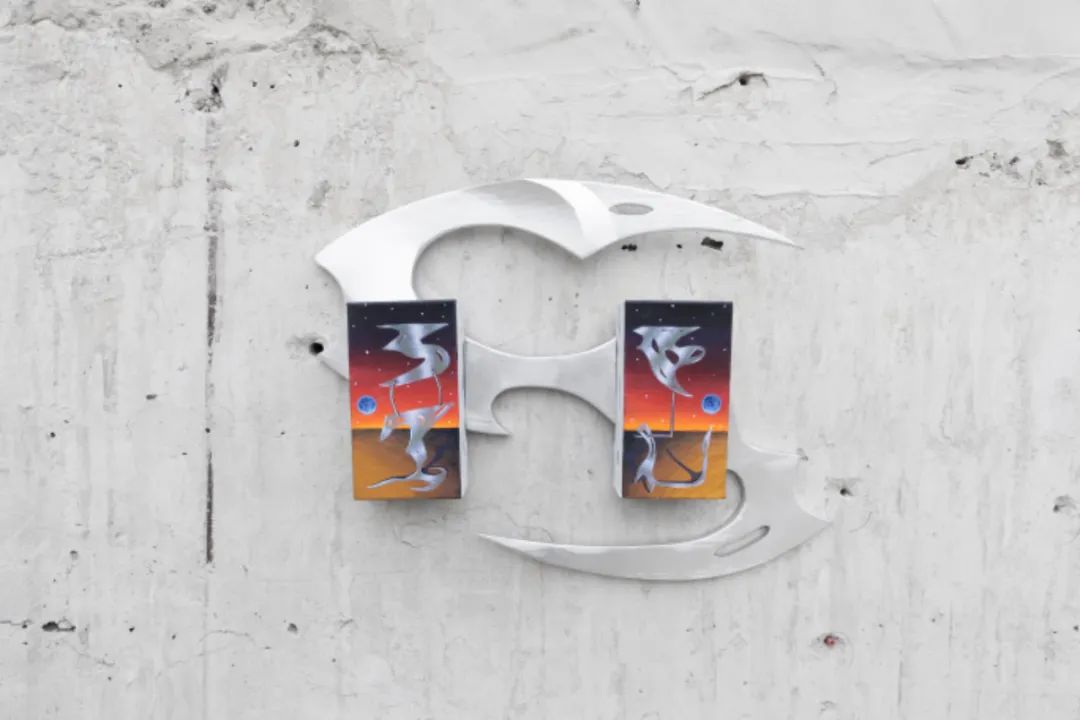
悬臂生物#1 Cantilever creatures#1, 30×40cm, 布面油画、光固化树脂 Oil on canvas, Light-cured resin, 2023

Q:怎么看待你所讨论的工具和人之间的关系?
A:不单是工具,我认为人的造物与人本身的关系就是很微妙的,有时人会被自己的造物影响和规训。例如建筑、科技产品、服装等等,甚至思想观念本身。在这批作品中我讨论的内核其实是控制与规训,所以作品中工具与人相互融合互相使用。有的作品一开始是从建构一个身体形象为出发点,过程中越来越像一个工具或者装置。而另外一些是相反的,目标先是装置但是越画越像个人。这是一个互相融合的过程,并在结束时达到一个模糊的状态。
Q: How do you view the relationship between the tools and humans discussed?
A: Not just tools, I think the relationship between human creations and humans themselves is quite subtle. Sometimes humans are influenced and disciplined by their own creations. Like buildings, technological products, clothing and even ideologies themselves. The core discussion in this batch of works is actually about control and discipline, so in these works, tools and humans blend and use each other. Some works initially start with constructing a human figure, and become more like a tool or apparatus during the process. Conversely, others start with a target apparatus but end up looking more like a person. This is a blending process, and reaches a vague state at the end.
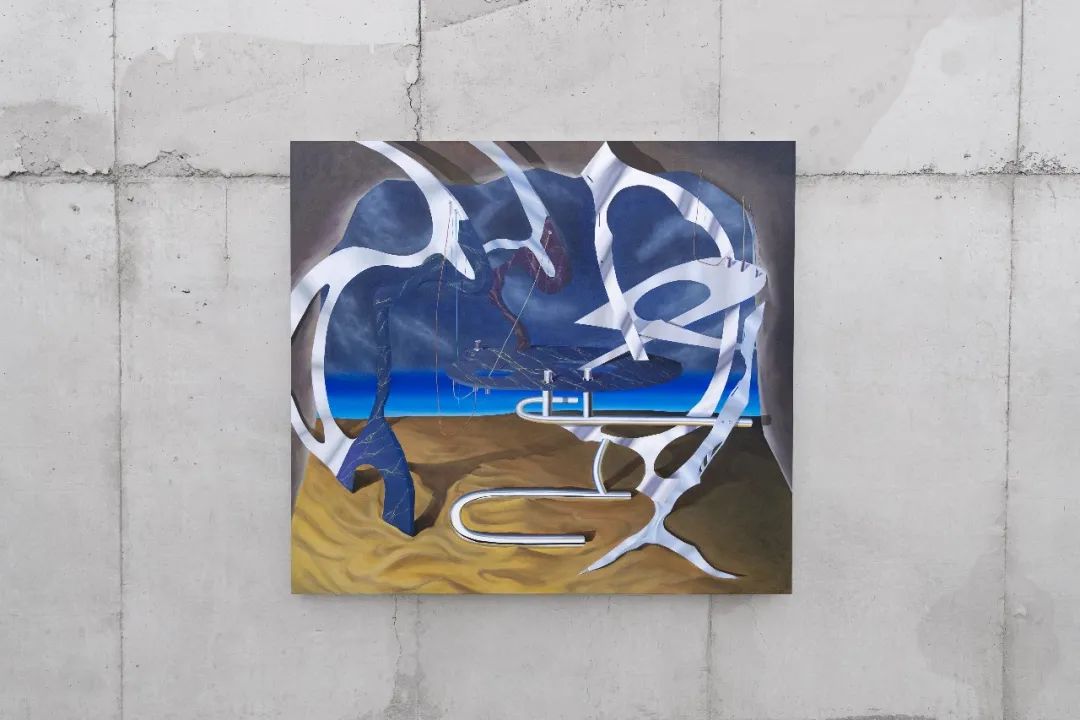
手术台 Operation table, 180×200cm, 布面油画 Oil on canvas, 2023
Q:为什么抛弃叙事性转而研究这种模糊的状态?
A:因为叙事会导致阅读路径的单一。像我曾经做的那部分工作一样,有很强的的言说意味。极其准确的表达某一个观点或者叙事,但是这样导致作品浅薄,容易被表面的东西吸引。而这两年不管是生活体验还是关注的问题已经不再是过去关注的幽默和批判。我更向想表达内部的个人的感受,这种感受无法再像之前那样使用符号能指和所指的游戏就能达到。它是复杂深邃的状态。如果太清晰就会缺少表达的神秘感,恰好留给观众更多的阅读空间。
Q: Why do you abandon narrativity and turn to studying this vague state?
A: Because narrative would lead to a single path of interpretation. Like some of the work I did before, there's a strong implication. Extremely accurate expression of a point or narrative, but this leads to superficial works, easily attracted by surface things. And in these two years, whether life experiences or concerns are no longer the humor and criticism concerned in the past. I want to express more of the internal personal feelings, and these feelings can no longer be achieved by the game of signifier and signified like before. It's a complex and profound state. If it's too clear, it will lack the mysterious sense of expression, leaving more reading space for the audience.

变态者绘画指南,SIMULACRA拟像,北京
Q:你的作品不止是画布正面,而是延伸到画框四周,以及3D打印包围在画的周围,你怎么理解创作媒介上的边界?
A:这里分两点。第一,对于绘画本身来说这次我画面延伸到边框目的是让这个作品看起来更立体。边框也成为画面叙事的一部分,就像建立一个可信的语境。第二,从更大的维度谈边界的话,我认为每种媒介都有属于自己的特殊“质感”。在之后创作和展览里我也会尝试把媒介之间的边界打破,用不同的方式构建我的视觉体系。
Q: Your works are not just confined to the front of the canvas, but extend to the frame all around, and are surrounded by 3D printing. How do you understand the boundaries in media?
A: There are two points. First, regarding painting itself, the extension of the image to the frame aims to make the work look more three-dimensional. The frame also becomes a part of the narrative of the image, like establishing a credible context. Second, speaking of boundaries from a broader dimension, I believe each medium has its own special "texture." In later creations and exhibitions, I will also try to break the boundaries between media, building my visual system in different ways.

Installation View, Artwork ©吴凌昊
Q:你新的作品中好像都使用了星空,月亮和沙丘的背景,这样做的原因是?
A:为了建立画面神秘感。而我的视觉偏好超现实主义和未来主义。也有因为一些文学作品的意象。
Q: Your new works seem to all use backgrounds of starry skies, the moon, and sand dunes. What's the reason for this?
A: It's to establish a sense of mystery in the image. Also, my visual preference leans towards surrealism and futurism. Moreover, it's influenced by the imagery of some literary works.
Q: 新作主要使用蓝色和红色两种色调,有什么特殊考虑吗?
A:跟我这生活体验,各类文学影视作品有关——电子乐Techno club,新浪潮科幻,后人类叙事等等。
Q: The new works primarily use blue and red tones, is there any special consideration?
A: It's related to my life experience, and various literary and film works—Techno club electronic music, New Wave science fiction, and post-human narratives, etc.

Installation View, Artwork ©吴凌昊
Q:这次很意识流的展览名称和作品的关系是什么?
A:受到威廉吉布森小说的启发,因为我的作品在某种层面也是意识流式的,就像一种“理性地说胡话的感觉”。人的思维并不全是一条直线的,很多时候是清晰与混乱并存。这次展览作品绝大部份也是这样的状态。
Q: What is the relationship between the very stream-of-consciousness exhibition title and the works?
A: It's inspired by William Gibson's novels, as my works are stream-of-consciousness on a certain level, much like a sense of "rationally speaking nonsense." Human thinking is not always linear; it's often a coexistence of clarity and confusion. The state of most works in this exhibition is like that.
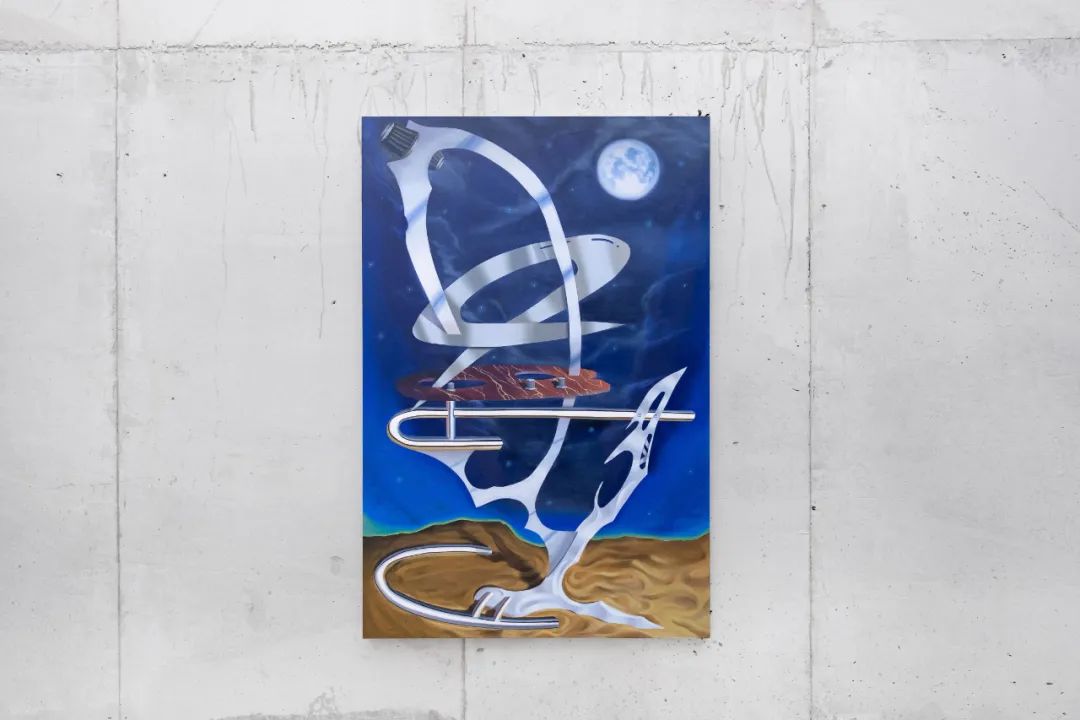
小提琴 Violin, 180×120cm, 布面油画 Oil on canvas, 2023
Q:你的作品背后杂糅了许多元素,如何保证这些元素不会使作品变得无序?
A:一是对于作品的控制力和把握媒介的能力。二是考虑清楚自己在做作品时的目标(无需事无巨细),不要在一件作品上什么都要。每件作品,每个系列,每次展览能表达的就那么一点别贪心。三是想清楚每个元素(例如造型,色彩,笔触,材料,具象图像,符号等等)在客观上的视觉感受,使用之后到底能不能从视觉上展现想表达的东西。
Q: Many elements are blended in your works, how do you ensure that these elements won’t make the works disordered?
A: First is the control over the work and the grasp of the medium. Second is to think clearly about the goal when creating a work (no need to be meticulous), don’t be greedy on one piece of work. Each piece, each series, each exhibition can only express so much. Third is to think clearly about the visual perception of each element (such as pattern, color, brushwork, material, concrete images, symbols, etc.) on an objective level, and whether they can visually display what you want to express after being used.

Installation View, Artwork ©吴凌昊
Q:后续会对这些元素做取舍吗?接下来工作的重点是什么?
A:会的。展览布置完毕后脑海里已经有些模糊的感觉。因为我从一开始的目标就是建构一个有观看深度和广度的视觉体系。必然不能长期依赖画面中单一元素。诚然这也需要每一段工作后对作品的总结和反思,时间与体验都很重要。
Q: Will there be a selection among these elements in the future? What is the focus of the upcoming work?
A: Yes. After the exhibition setup, there are some vague feelings in my mind. Because my goal from the beginning was to construct a visual system with viewing depth and breadth. It's inevitable that I cannot rely on a single element in the image for a long time. Indeed, this also requires a summary and reflection on the work after each period of work, time and experience are very important.

艺术家于上海工作室 ©吴凌昊
©文章版权归属原创作者,如有侵权请后台联系删除